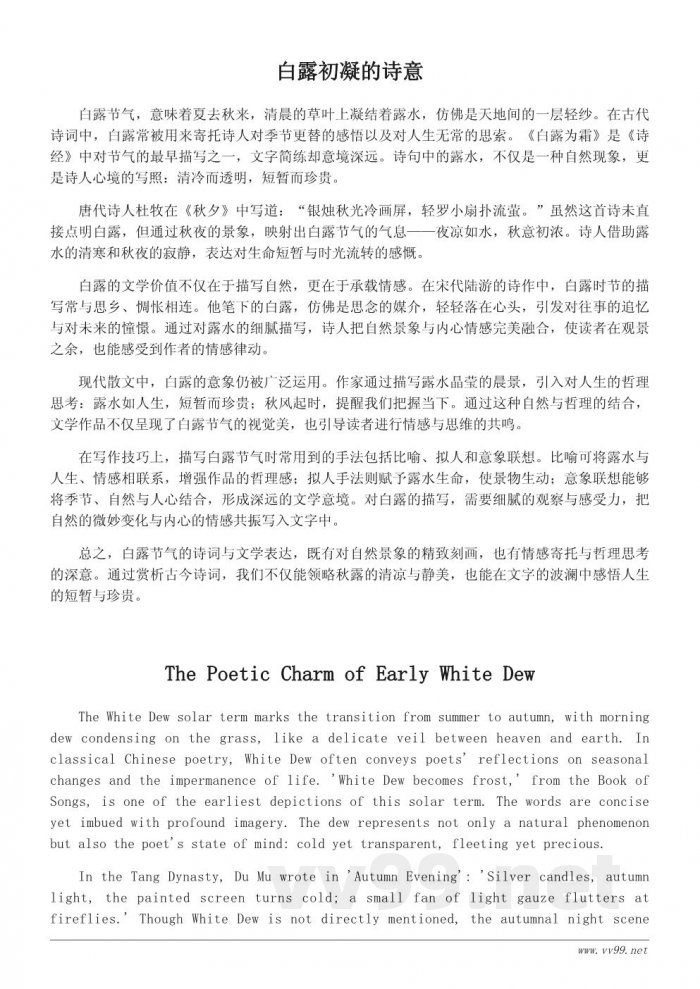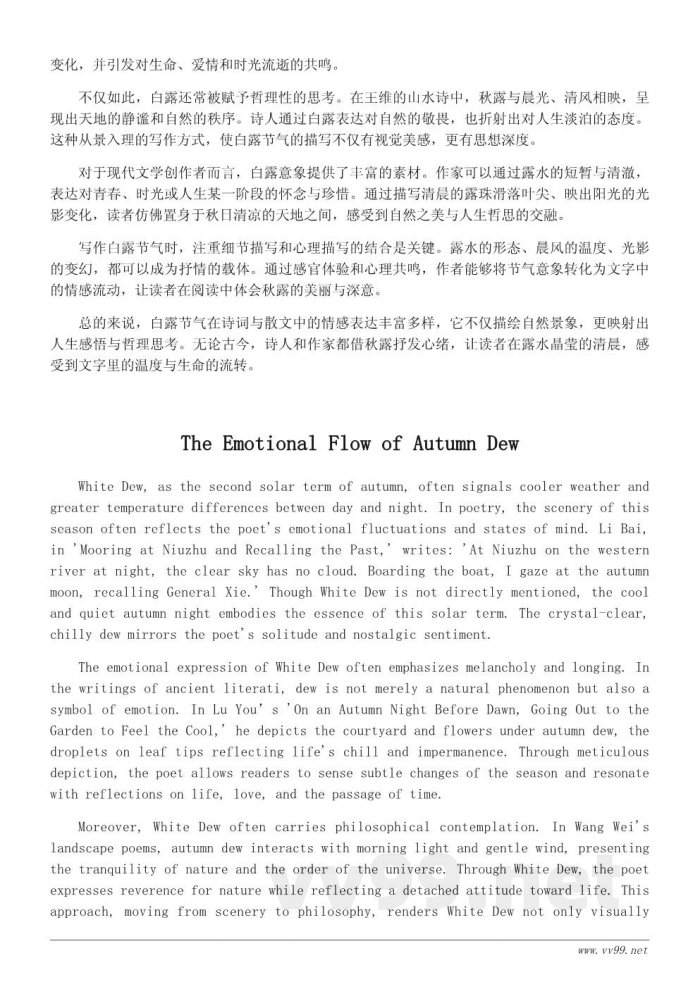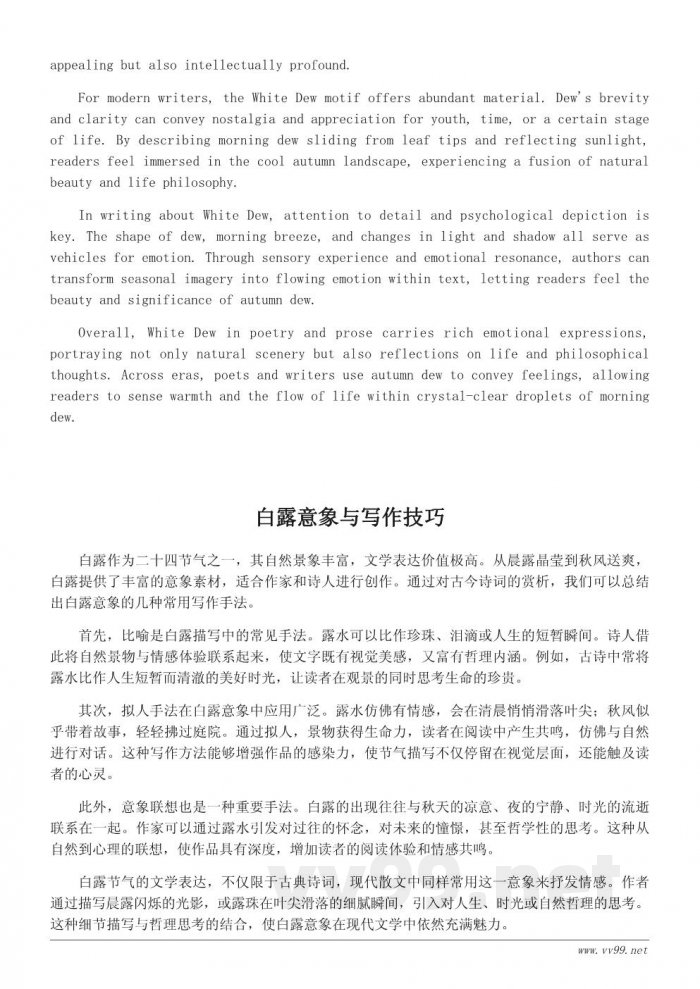白露初凝的诗意
白露节气,意味着夏去秋来,清晨的草叶上凝结着露水,仿佛是天地间的一层轻纱。在古代诗词中,白露常被用来寄托诗人对季节更替的感悟以及对人生无常的思索。《白露为霜》是《诗经》中对节气的最早描写之一,文字简练却意境深远。诗句中的露水,不仅是一种自然现象,更是诗人心境的写照:清冷而透明,短暂而珍贵。
唐代诗人杜牧在《秋夕》中写道:“银烛秋光冷画屏,轻罗小扇扑流萤。”虽然这首诗未直接点明白露,但通过秋夜的景象,映射出白露节气的气息——夜凉如水,秋意初浓。诗人借助露水的清寒和秋夜的寂静,表达对生命短暂与时光流转的感慨。
白露的文学价值不仅在于描写自然,更在于承载情感。在宋代陆游的诗作中,白露时节的描写常与思乡、惆怅相连。他笔下的白露,仿佛是思念的媒介,轻轻落在心头,引发对往事的追忆与对未来的憧憬。通过对露水的细腻描写,诗人把自然景象与内心情感完美融合,使读者在观景之余,也能感受到作者的情感律动。
现代散文中,白露的意象仍被广泛运用。作家通过描写露水晶莹的晨景,引入对人生的哲理思考:露水如人生,短暂而珍贵;秋风起时,提醒我们把握当下。通过这种自然与哲理的结合,文学作品不仅呈现了白露节气的视觉美,也引导读者进行情感与思维的共鸣。
在写作技巧上,描写白露节气时常用到的手法包括比喻、拟人和意象联想。比喻可将露水与人生、情感相联系,增强作品的哲理感;拟人手法则赋予露水生命,使景物生动;意象联想能够将季节、自然与人心结合,形成深远的文学意境。对白露的描写,需要细腻的观察与感受力,把自然的微妙变化与内心的情感共振写入文字中。
总之,白露节气的诗词与文学表达,既有对自然景象的精致刻画,也有情感寄托与哲理思考的深意。通过赏析古今诗词,我们不仅能领略秋露的清凉与静美,也能在文字的波澜中感悟人生的短暂与珍贵。
The Poetic Charm of Early White Dew
The White Dew solar term marks the transition from summer to autumn, with morning dew condensing on the grass, like a delicate veil between heaven and earth. In classical Chinese poetry, White Dew often conveys poets' reflections on seasonal changes and the impermanence of life. 'White Dew becomes frost,' from the Book of Songs, is one of the earliest depictions of this solar term. The words are concise yet imbued with profound imagery. The dew represents not only a natural phenomenon but also the poet's state of mind: cold yet transparent, fleeting yet precious.
In the Tang Dynasty, Du Mu wrote in 'Autumn Evening': 'Silver candles, autumn light, the painted screen turns cold; a small fan of light gauze flutters at fireflies.' Though White Dew is not directly mentioned, the autumnal night scene evokes its essence—the night is cool, and autumn has just begun. Through the depiction of dew's chill and the quiet of the autumn night, the poet expresses sentiments on life's brevity and the passage of time.
The literary value of White Dew lies not only in describing nature but also in carrying emotions. In Song Dynasty poet Lu You’s works, depictions of White Dew often intertwine with feelings of homesickness and melancholy. The dew acts as a medium of remembrance, lightly falling upon the heart, sparking reflections on past events and aspirations for the future. Through delicate portrayals, the poet blends natural scenery with inner emotions, allowing readers to resonate emotionally while appreciating the landscape.
In modern prose, White Dew remains a popular motif. Writers use the sparkling morning dew to introduce reflections on life: dew, like life, is transient and precious; with the autumn wind, we are reminded to seize the present. By combining nature and philosophy, literary works not only present the visual beauty of the White Dew season but also resonate with readers' emotions and thoughts.
Writing techniques for depicting White Dew often include metaphor, personification, and imagery association. Metaphors link dew to life or emotions, enhancing philosophical depth; personification gives dew vitality, making the scene vivid; imagery association connects seasons, nature, and human feelings to create profound literary effects. Observing and feeling the subtle changes of nature, and reflecting inner emotions, is essential for capturing the essence of White Dew in writing.
In summary, poetry and literature about the White Dew solar term not only delicately portray nature but also carry emotions and philosophical insights. Through the appreciation of classical and modern poetry, we can enjoy the cool serenity of autumn dew while reflecting on the fleeting and precious nature of life.
秋露的情感流转
白露,作为秋季的第二个节气,其出现往往意味着天气渐凉,昼夜温差增大。在诗词中,这一时节的景象常被用来映射诗人的情感起伏与心境变化。李白在《夜泊牛渚怀古》中写到:“牛渚西江夜,青天无片云。登舟望秋月,空忆谢将军。”虽未直接提到白露,但秋夜的凉意与静谧,正是白露节气的写照。露水晶莹而寒凉,映射出诗人心头的孤寂与怀古之情。
白露节气的情感表达,多以感伤、思念为主。在古代文人笔下,露水不仅是一种自然现象,更是寄托情绪的符号。陆游的《秋夜将晓出篱门迎凉有感二首》中描绘了秋露下的庭院与花木,露水滴落在叶尖,映出人生的清冷与无常。通过细致的景物描写,诗人让读者感受到节气的微妙变化,并引发对生命、爱情和时光流逝的共鸣。
不仅如此,白露还常被赋予哲理性的思考。在王维的山水诗中,秋露与晨光、清风相映,呈现出天地的静谧和自然的秩序。诗人通过白露表达对自然的敬畏,也折射出对人生淡泊的态度。这种从景入理的写作方式,使白露节气的描写不仅有视觉美感,更有思想深度。
对于现代文学创作者而言,白露意象提供了丰富的素材。作家可以通过露水的短暂与清澈,表达对青春、时光或人生某一阶段的怀念与珍惜。通过描写清晨的露珠滑落叶尖、映出阳光的光影变化,读者仿佛置身于秋日清凉的天地之间,感受到自然之美与人生哲思的交融。
写作白露节气时,注重细节描写和心理描写的结合是关键。露水的形态、晨风的温度、光影的变幻,都可以成为抒情的载体。通过感官体验和心理共鸣,作者能够将节气意象转化为文字中的情感流动,让读者在阅读中体会秋露的美丽与深意。
总的来说,白露节气在诗词与散文中的情感表达丰富多样,它不仅描绘自然景象,更映射出人生感悟与哲理思考。无论古今,诗人和作家都借秋露抒发心绪,让读者在露水晶莹的清晨,感受到文字里的温度与生命的流转。
The Emotional Flow of Autumn Dew
White Dew, as the second solar term of autumn, often signals cooler weather and greater temperature differences between day and night. In poetry, the scenery of this season often reflects the poet's emotional fluctuations and states of mind. Li Bai, in 'Mooring at Niuzhu and Recalling the Past,' writes: 'At Niuzhu on the western river at night, the clear sky has no cloud. Boarding the boat, I gaze at the autumn moon, recalling General Xie.' Though White Dew is not directly mentioned, the cool and quiet autumn night embodies the essence of this solar term. The crystal-clear, chilly dew mirrors the poet's solitude and nostalgic sentiment.
The emotional expression of White Dew often emphasizes melancholy and longing. In the writings of ancient literati, dew is not merely a natural phenomenon but also a symbol of emotion. In Lu You’s 'On an Autumn Night Before Dawn, Going Out to the Garden to Feel the Cool,' he depicts the courtyard and flowers under autumn dew, the droplets on leaf tips reflecting life's chill and impermanence. Through meticulous depiction, the poet allows readers to sense subtle changes of the season and resonate with reflections on life, love, and the passage of time.
Moreover, White Dew often carries philosophical contemplation. In Wang Wei's landscape poems, autumn dew interacts with morning light and gentle wind, presenting the tranquility of nature and the order of the universe. Through White Dew, the poet expresses reverence for nature while reflecting a detached attitude toward life. This approach, moving from scenery to philosophy, renders White Dew not only visually appealing but also intellectually profound.
For modern writers, the White Dew motif offers abundant material. Dew's brevity and clarity can convey nostalgia and appreciation for youth, time, or a certain stage of life. By describing morning dew sliding from leaf tips and reflecting sunlight, readers feel immersed in the cool autumn landscape, experiencing a fusion of natural beauty and life philosophy.
In writing about White Dew, attention to detail and psychological depiction is key. The shape of dew, morning breeze, and changes in light and shadow all serve as vehicles for emotion. Through sensory experience and emotional resonance, authors can transform seasonal imagery into flowing emotion within text, letting readers feel the beauty and significance of autumn dew.
Overall, White Dew in poetry and prose carries rich emotional expressions, portraying not only natural scenery but also reflections on life and philosophical thoughts. Across eras, poets and writers use autumn dew to convey feelings, allowing readers to sense warmth and the flow of life within crystal-clear droplets of morning dew.
小提示:上面此文档内容仅展示完整文档里的部分内容, 若需要下载完整文档请 点击免费下载完整文档 。





